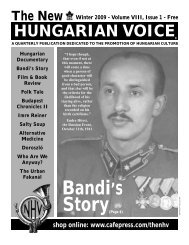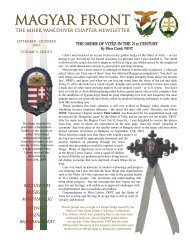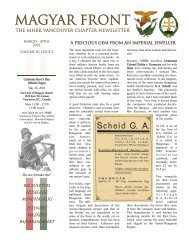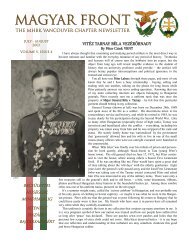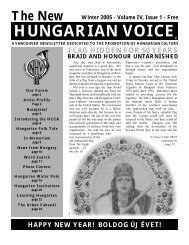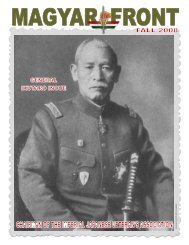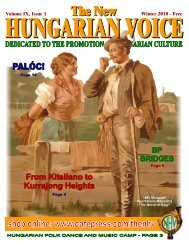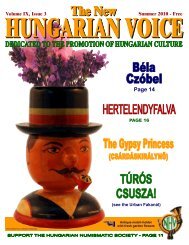THE NEW HUNGARIAN VOICE FALL 2003 (Read-Only)
THE NEW HUNGARIAN VOICE FALL 2003 (Read-Only)
THE NEW HUNGARIAN VOICE FALL 2003 (Read-Only)
You also want an ePaper? Increase the reach of your titles
YUMPU automatically turns print PDFs into web optimized ePapers that Google loves.
There is an old form of Hungarian writing that is presently<br />
going through a rebirth in scholarly circles and among code and<br />
runic enthusiasts. Rovásírás (from rovás ‘incised’ and írás<br />
‘writing’) predates Hungary’s adoption of the Latin alphabet<br />
and is a descendant from the Kök Turki script used in Central<br />
Asia.<br />
Many believe that the Christianization<br />
of Hungary promoted the disuse<br />
of rovásírás. It was considered rather<br />
important at the time to absolve the<br />
country of its old pagan beliefs and<br />
practices in order to continue to gain<br />
favour from the rest of Europe. It is<br />
therefore reasonable to believe that<br />
pre-European Hungarian relics are the<br />
key to our awareness and understanding<br />
of this ancient form of communication.<br />
Interestingly, the opposite is<br />
true. It was largely Christian monks<br />
and priests that continued the use of<br />
rovásírás as the Latin alphabet’s adaptation<br />
to the characteristics of the<br />
Hungarian language was not immediate.<br />
A religious order of monks called<br />
the Pauline Order (Pálos) lay claim to a<br />
proprietary form of rovásírás. The pálos rovásírás was widely<br />
used by the order from its establishment during the reign of<br />
tribal leader and Hungarian conqueror, Árpád, until the XIVth<br />
century. It was especially useful in the letters of Pauline<br />
missionaries sent to South America. They would report home<br />
on the abuses of the natives at the hands of the Spanish and<br />
Portuguese using rovásírás as a form of code. As with the Latin<br />
alphabet, pálos was written left-to-right. Pálos rovásírás was<br />
not developed as a complete and detailed form of communication<br />
and fell completely out of use by the XVIth century.<br />
The second form of ancient Hungarian runic writing is called<br />
székely rovásírás. It originates from the Székely Magyars in<br />
Eastern Hungary (Székelyföld), currently the land of the<br />
Hungarian speaking Székelys of Transylvania. While this form<br />
of rovásírás has been written both left-to-right and right-to-left,<br />
the latter is more prevalent – perhaps because writers would<br />
typically hold a small piece of wood in their left-hand, and<br />
carve the letters with their right. When they reached the end of<br />
the stick, they turned it around, so the next line is upside-down<br />
compared to the first.<br />
In the XIIIth century, a strong interest in székely rovásírás<br />
grew and it gained popularity in the royal courts and by the<br />
intelligentsia. The Hungarian Renaissance ruler, King Matthias,<br />
often used this form of rovásírás and while the Latin alphabet<br />
was considered the official way of correspondence, rovásírás<br />
was highly fashionable. In the 1500s, when Hungary was<br />
devastated by the Ottoman Turks, the independent Transylvanian<br />
Principality wanted to make székely rovásírás the official<br />
ROVÁSÍRÁS<br />
<strong>THE</strong> <strong>HUNGARIAN</strong> RUNIC ALPHABET<br />
Transylvanian Church ceiling panel<br />
with Székely rovásírás.<br />
12<br />
form of correspondence. Rovásírás continued to be used<br />
throughout Hungary until the mid 1800s.<br />
The ancient writers of rovásírás wrote on hard materials<br />
(wood and stone). This obviously made writing lengthy and<br />
difficult and therefore, several shorthand features developed.<br />
One is the concentration or melting<br />
together of two or more neighbouring<br />
letters. These combined characters<br />
have been referred to as ligatures. The<br />
writer has relative freedom in deciding<br />
which characters will be ligatures<br />
based on space and decipherability.<br />
Another shorthand feature was omitting<br />
some of the vowels – the letter ‘e’<br />
was most commonly omitted. There<br />
were also sound characters that were<br />
bug-like symbols strongly resembling<br />
Egyptian hieroglyphs. The bug<br />
symbols are age-old Székely characters<br />
that point our origins to the<br />
nations of the ancient Middle East.<br />
The rovásírás numbers resemble roman<br />
numerals – this is due to the fact that<br />
they evolved from the same root, the<br />
Etrusk numbers.<br />
Rovásírás relics have been found throughout Hungary,<br />
Transylvania and to a lesser extent Asia and other parts of<br />
Europe but the most famous is a 181kg piece of sandstone<br />
found in Nova Scotia, Canada in the 1700s. The 78cm x 70cm x<br />
50cm stone had ancient runes carved into it, of which a portion<br />
had been worn down. Although the text was unidentifiable<br />
using Scandinavian runes, it was strongly believed that it was a<br />
Viking relic left from an expedition of Eric the Red or his son,<br />
Leif Ericsson. It wasn’t until 1984 that Silvia Luis, a Hungarian<br />
runic writing expert, happened across and deciphered the text -<br />
it read: “…son járt e hejen is sok társával” (“…son traveled<br />
through this area with many of his companions”). It is widely<br />
believed that the worn portion originally read ‘Erics’-son<br />
referring to Leif Ericsson. It has been long contended that one<br />
of Leif Ericsson’s men, referred to only as ‘Tyrker’, was an<br />
Árpádian Magyar. Experts have established that the name<br />
Tyrker came from a Byzantine, Arab and European designation<br />
of the early Magyars as Tourks – this reference was due to the<br />
Kök Turks of Central Asia. An additional theory exists stating<br />
that after his expeditions with Ericsson, Tyrker returned to<br />
Hungary with maps and knowledge of the ‘new world’.<br />
If all this is true, we Hungarians have an amazing claim of<br />
having a fellow countryman explore North America long before<br />
Christopher Columbus ‘discovered it’.<br />
Lajos S. Miklós Jr.<br />
To read more about rovásírás on the Internet, check out<br />
http://fang.fa.gau.hu/~heves/runic.html.



